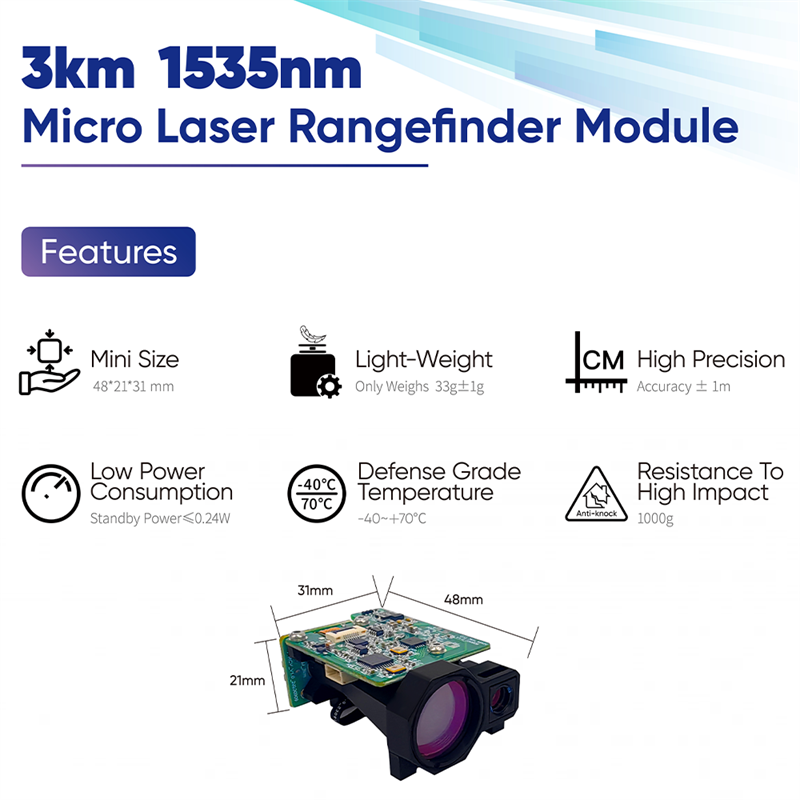With the continuous advancement of technology and the growing demand for application in various fields, laser rangefinder technology has become widely used across industries, from autonomous driving and drone photography to measuring equipment and sports gear. Among these, the compactness and lightweight nature of laser rangefinder modules have become one of their core advantages, making them a key factor in modern measurement devices.
1. Basic Concept of Laser Rangefinder Modules
A laser rangefinder module is a high-precision measuring tool that calculates the distance between an object and a device by emitting a laser beam and receiving the reflected light. Compared to traditional measuring tools, laser rangefinder modules can operate effectively in environments requiring long-range and high-precision measurements. Typically, they consist of a laser emitter, receiver, and associated processing circuits.
2. Core Advantages of Compact and Lightweight Design
Improved Portability: As the application scenarios for laser rangefinder technology expand, the demand for portability in devices continues to rise. A lightweight laser rangefinder module can significantly reduce the overall weight of the measuring equipment, making it easier to carry. For example, in outdoor sports, aerial photography, and military fields, carrying heavy equipment can greatly hinder operational convenience. A compact laser rangefinder module reduces the weight of the device, enhancing portability, and allowing users to perform measurements more flexibly and efficiently.
Space Saving: In small devices or embedded systems, space constraints are a major consideration in design. The compact design of laser rangefinder modules allows them to be easily integrated into various compact devices, especially for applications in drones, smart glasses, and sports measuring instruments. By minimizing the size of the module, not only is the integration density improved, but greater freedom is also provided for innovative designs.
Lower Power Consumption: Lightweight and compact laser rangefinder modules are often designed for greater efficiency, using advanced low-power circuits and materials that reduce energy consumption. Reduced power consumption allows these modules to run longer in applications that require extended operation times. For example, in field exploration or aerial photography tasks, long-duration work typically relies on battery power. Low-power modules can effectively extend battery life and reduce the need for frequent recharging.
Enhanced Response Speed and Operational Convenience: Due to their small size, laser rangefinder modules generally have higher integration, which makes the operating system more compact and efficient, reducing response times. In scenarios where quick and accurate data is required, lightweight, small modules can rapidly complete measurement tasks, improving operational efficiency. Additionally, their compact design is more suitable for handheld devices, enabling users to operate the equipment more accurately and conveniently.
3. Application Examples
Drone Rangefinding: Drones, when performing aerial photography and surveying tasks, typically require a variety of sensors for measurement. The lightweight design of laser rangefinder modules makes them an essential component for drones. Since the laser rangefinder module is small and light, the drone’s flight stability and endurance are optimized, while also providing precise ground distance data, helping the drone with autonomous obstacle avoidance and accurate positioning.
Smart Glasses and Sports Equipment: With the popularity of smart glasses and sports equipment, the compactness and lightness of laser rangefinder modules have become key factors in enhancing the user experience. In smart glasses, the laser rangefinder module can be used to quickly measure distances and provide an augmented reality (AR) experience; in sports equipment, the module helps athletes with quick distance measurement, providing precise training data that improves performance.
Autonomous Driving and Robotics: Autonomous vehicles and robots have very high requirements for precise distance measurement. Laser rangefinder modules, with their compactness and reliability, can help these devices achieve accurate distance detection and environmental perception. Their small size allows the laser sensor to be easily integrated into autonomous driving and robotic systems, providing more accurate sensing capabilities while ensuring the overall weight of the device does not affect system performance.
4. Conclusion
Compactness and lightweight design are important advantages of laser rangefinder modules in modern technology applications. They not only enhance the portability and response speed of devices but also optimize energy consumption and space utilization. In the future, as the demand for laser rangefinder technology increases in more high-tech fields, these advantages will continue to drive the widespread application of laser rangefinder modules across industries, promoting technological progress and innovation.
Lumispot
Address: Building 4 #, No.99 Furong 3rd Road, Xishan Dist. Wuxi, 214000, China
Tel: + 86-0510 87381808.
Mobile: + 86-15072320922
Email: sales@lumispot.cn
Post time: Nov-11-2024

